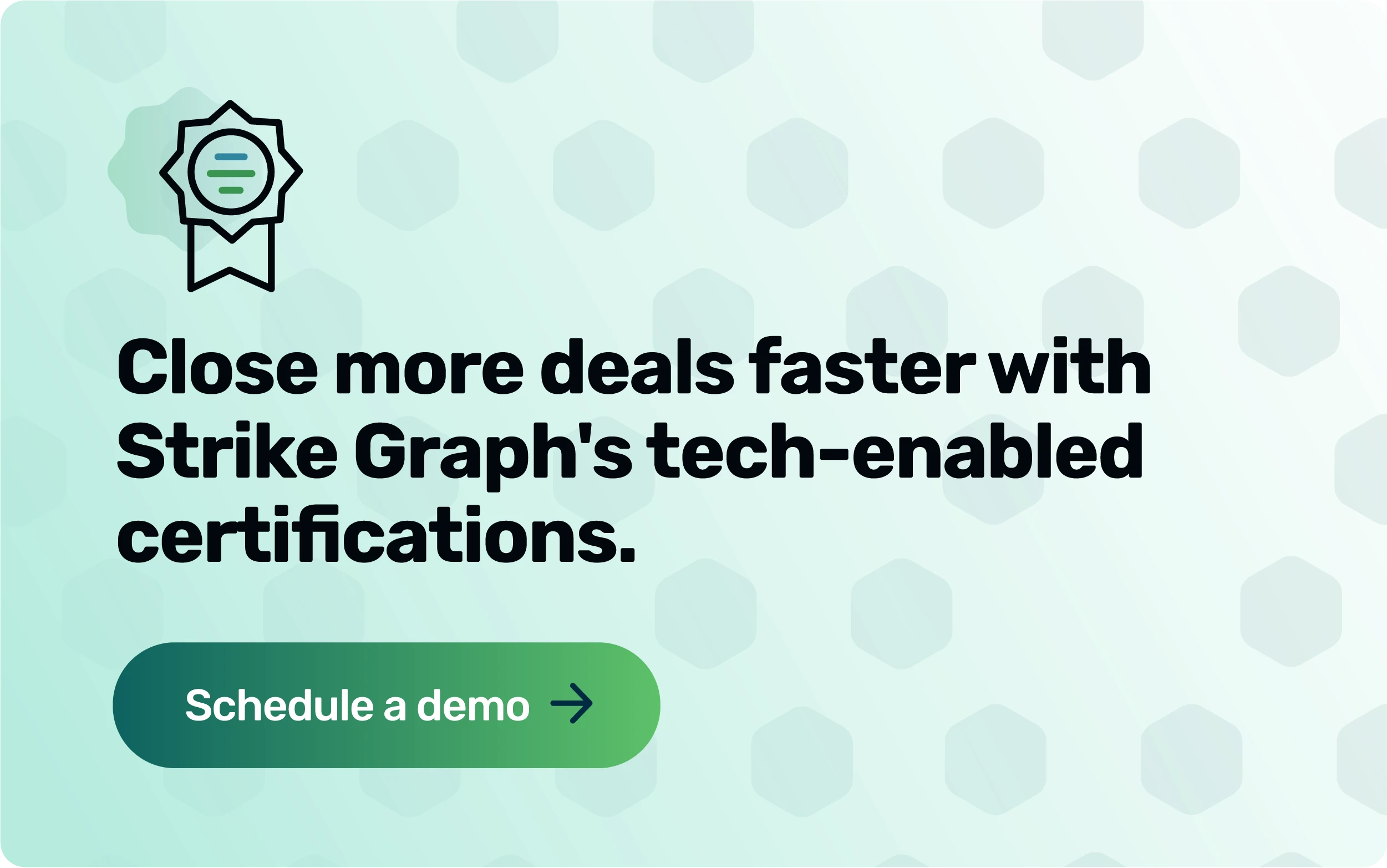Security frameworks are essential to your business. They can provide your organization with a structured approach to addressing cybersecurity challenges, mitigating risks, and ensuring the protection of valuable assets and data.
And the benefits don’t stop there. They also result in certifications that boost your business’s reputation, increase customer trust and loyalty, improve vendor relationships, give you an advantage over the competition, and create opportunities for more revenue.
The industry you’re in will determine which security frameworks you should be implementing. In this guide, we’ll take a deep dive into the different frameworks that are important for different industries according to their specific risks and regulations.
Here’s a quick visual reference of the 10 industries we’ll be covering, as well as some of the most popular frameworks for each. In the sections dedicated to each industry below, we’ll go deeper into other, additional frameworks you might want to consider.

Healthcare
In the healthcare industry — including eHealth companies — many concerns arise over the privacy of patient health records, as well as the security of legacy systems, mobile health apps, cloud systems, telemedicine, medical devices, and more.
In order to ensure the security of such integral data and systems, specific frameworks have been created to help healthcare providers better protect their business operations and patients’ information. Three of the most common are below:
- HIPAA: The Health Insurance Portability and Accountability Act’s primary focus is on ensuring the privacy and security of sensitive health information, also known as Protected Health Information (PHI), including ePHI.
- SOC 2: Service Organization Control 2 focuses on the security, availability, processing integrity, confidentiality, and privacy of data processed by service organizations — such as healthcare providers — that handle sensitive customer data.
- HITRUST CSF: The Health Information Trust Alliance Common Security Framework is designed to address and manage the various security, privacy, and regulatory challenges faced by organizations in the healthcare industry, providing a standardized approach for them to assess, manage, and enhance their information protection programs.
Compliance with these regulations can not only enhance healthcare organizations’ security postures, but also increase their ability to meet regulatory requirements, create new business opportunities, and boost their reputation. On the other hand, if organizations don’t comply, they can suffer legal, financial, and reputational impacts, including fines and penalties ranging from thousands to millions of dollars, reputational damage, operational disruption, loss of customer trust, and more.
Strike Graph’s flexible compliance platform allows companies to tackle multiple frameworks at once, saving time and resources. HIPAA and SOC 2 are particularly good certifications to seek simultaneously because of the large overlap between them.
Ecommerce
Due to the nature of online transactions and the constant threat of cyberattacks, the ecommerce industry faces a range of security concerns surrounding the handling of sensitive customer data. This is why the following security frameworks have been developed:
- PCI DSS: The Payment Card Industry Data Security Standard is designed to ensure the protection of payment card data and sensitive customer information during both online and in-person transactions.
- ISO 27001: ISO/IEC 27001 was established jointly by the International Organization for Standardization and the International Electrotechnical Commission as an international standard for information security management systems (ISMS). It provides a systematic approach to establish, implement, operate, monitor, review, maintain, and improve information security controls and processes and is the gold standard for e-commerce companies doing business globally.
- SOC 2: SOC 2 can be a critical component of a comprehensive data protection strategy for ecommerce companies, helping them build trust with customers, ensure regulatory compliance, mitigate security risks, and enhance overall operational and cybersecurity practices.
There are also additional privacy regulations where applicable, including GDPR, CCPA/CPRA, TRUSTe, CSA STAR, and NIST CSF. All of these frameworks are important for ecommerce companies because they address various aspects of information security, data protection, and operational integrity, which are crucial for maintaining customer trust, preventing data breaches, and ensuring the overall success of ecommerce operations.
Strike Graph’s compliance platform supports PCI DSS, ISO 27001, SOC 2 as well as the most common privacy frameworks (including GDPR, ISO 27701 and CPRA) so you can manage your entire security posture in one place. And, our trust asset library lets you easily share certifications and security reports with customers and stakeholders.
Finance industry
When it comes to the finance industry, security threats like breaches of financial data, payment fraud, and fintech risks are constantly looming. The following frameworks have been introduced to curb these threats:
- SOC 1: Service Organization Control 1 is an auditing standard designed to assess the internal controls of service organizations that impact their clients' financial reporting.
- SOC 2: SOC 2 can help companies in the finance industry ensure regulatory compliance, protect their data, better manage risk, improve internal processes, and more.
- SOX: The Sarbanes-Oxley Act is a United States federal law that was enacted to enhance transparency, accuracy, and reliability in financial reporting and to improve corporate governance and accountability. In fact, any public company should have SOX.
- GLBA: The Gramm-Leach-Bliley Act is a U.S. federal law that addresses the privacy and security of personal financial information held by financial institutions.
- NIST CSF: The National Institute of Standards and Technology Cybersecurity Framework helps organizations manage and improve their cybersecurity risk management processes by providing a structured approach for organizations to assess, develop, and enhance their cybersecurity practices regardless of their size, industry, or sector.
Privacy frameworks — such as GDPR and CCPA/CPRA — may also be appropriate for companies in the finance industry depending on where their customers are located.
All of these frameworks serve to protect companies in the finance industry by addressing various aspects of financial reporting, data security, privacy, and risk management. They can help enhance transparency and accountability in financial reporting, strengthen security controls, protect customer data, reduce the risk of data breaches, fraud, and cyberattacks, and more.
Because companies in the finance industry must adhere to a wide range of regulations and security frameworks, having a comprehensive TrustOps platform that can grow with changing security needs makes sense. Strike Graph leverages the work you’ve already done for previous certifications to make future certifications faster and easier.
Education industry
Given the increasing integration of technology into education, the sensitive nature of student data, and the need to balance open access with data protection, the education industry has a variety of security concerns to consider. The following security frameworks help address these issues:
- StateRAMP: The State Risk and Authorization Management Program, modeled after FedRAMP, is designed to provide a standardized approach to assessing and managing the security risks of cloud services used by state and local government agencies.
- SOC 2: SOC 2 can be specifically tailored to educational technology (EdTech) companies. It helps these companies keep student data safe, allowing them to build trust, mitigate risks, and improve internal processes, ultimately benefiting educational institutions, educators, students, and parents who rely on these platforms for learning and educational support.
- FERPA: The Family Educational Rights and Privacy Act is a US federal law that protects the privacy of student education records and gives certain rights to parents, guardians, and eligible students.
- CIPA: The Children's Internet Protection Act is a federal law that addresses internet safety and access to explicit content in schools and libraries that receive federal funding for internet access or technology. The goal is to protect children from inappropriate or harmful online content.
- NIST CSF: Adopting the NIST Cybersecurity Framework can benefit EdTech companies by providing a robust and widely accepted framework for strengthening cybersecurity, meeting regulatory requirements, protecting sensitive data, managing risks, and building trust with educational institutions and users alike.
Like many industries, other privacy regulations in the education sector may include GDPR and CCPA/CPRA. Together, these frameworks ensure the security, privacy, and compliance of these companies’ services, creating a safe and trustworthy environment for students, educators, and institutions while maintaining the integrity of educational technology services.
The Strike Graph compliance and certification platform is perfect for EdTech companies. Multi-framework mapping allows education companies to pursue multiple certifications simultaneously. And, our risk-based approach means companies only address the risks that apply to their unique business situation, saving time and money. Read how we helped one EdTech company land more contracts.
Government contractors
Government contractors face a unique set of security concerns due to their involvement in projects and services that require handling sensitive and classified information on behalf of government agencies. Due to the highly sensitive nature of this information, the following frameworks have been developed:
- ISO 27001: Implementing ISO 27001 can offer government contractors a strategic advantage by ensuring regulatory compliance, enhancing security practices, managing risks, and building trust with government agencies. It aligns with the specific needs and expectations of the government sector, making it a valuable investment for contractors involved in government projects.
- NIST 800-171: Part of the National Institute of Standards and Technology (NIST) Special Publication 800 series, NIST 800-171 outlines a set of security requirements designed to protect Controlled Unclassified Information (CUI) in nonfederal systems and organizations and can help contractors build towards CMMC.
- NIST 800-53: This framework offers guidelines for designing and implementing effective security measures to protect the confidentiality, integrity, and availability of information and systems for US Federal Government agencies and prepares contractors to pass their FedRAMP audit.
- FISMA: The Federal Information Security Management Act is designed to improve the cybersecurity posture of federal government agencies by establishing a framework for managing information security and ensuring the protection of sensitive and valuable government information and systems.
- ITAR: The International Traffic in Arms Regulations is a set of US government regulations that control the export and import of defense-related articles, services, and technical data so that they don’t fall into the wrong hands.
- DFARS: The Defense Federal Acquisition Regulation Supplement is used by the US Department of Defense (DoD) to establish specific requirements for defense contracts and acquisitions — including procurement, contract management, and compliance — with a focus on national security and defense-related matters.
- CIS Controls: The Center for Internet Security Controls are a set of best practices and guidelines designed to help organizations improve their cybersecurity posture and defend against common cyber threats. These were developed in response to extreme data losses experienced by organizations in the US defense industrial base.
- NIST CSF: NIST can help government contractors meet regulatory requirements, align with government standards, manage cybersecurity risks, protect sensitive data, and enhance their competitive position when pursuing government contracts.
Why are these frameworks important for government contractors? Because in addition to enhancing cybersecurity posture, they also protect sensitive information and national security interests, ensure the integrity of government operations and projects, and increase the overall effectiveness of government contractor operations.
Using Strike Graph’s all-in-one platform to achieve ISO 27001 and NIST 800-171 compliance, sets companies up to land government contracts and easily expand to CMMC and other security frameworks they may need in the future.
Tech
While this section is a bit of a catch all for the tech industry as a whole, many tech companies face similar security challenges, including data breaches, intellectual property theft, supply chain vulnerabilities, and cloud security. The below frameworks have been designed to address many of these concerns, but tech companies will need to see if any other frameworks apply to them depending on which industries they’re doing business in.
- ISO 27001: This framework can benefit tech companies by helping them reduce costs associated with security vulnerabilities and inefficiencies, improve incident response planning and execution, promote a culture of continuous improvement, and more.
- SOC 2: SOC 2 helps tech companies provide assurance to customers that their sensitive data is being handled securely. It also gives them a leg up over the competition and helps them assess the security practices of third-party vendors and cloud service providers.
- ITIL: The Information Technology Infrastructure Library is a set of best practices and guidelines for managing and delivering IT services effectively and efficiently. It provides a framework for aligning IT services with the needs of the business, improving service quality, and optimizing IT processes.
- NIST CSF: The NIST framework is suitable for all tech companies, especially those that must adhere to specific compliance requirements, including HIPAA, GDPR, and industry-specific standards like PCI DSS. It can also help them build trust with customers, partners, investors, and regulatory authorities alike.
These frameworks address crucial aspects of information security and data privacy, helping tech companies demonstrate their commitment to safeguarding sensitive data, maintaining secure operations, and meeting the expectations of clients and partners.
With Strike Graph, tech companies can ensure they comply with all ISO 27001 and SOC 2 requirements faster and more efficiently.
The internet of things (IoT)
The Internet of Things, or IoT, presents unique security challenges due to its interconnected nature and the diversity of devices and technologies involved. As IoT devices become more prevalent in various sectors — including consumer electronics, healthcare, and industrial automation — addressing these security concerns becomes crucial. This is why the following frameworks have been developed:
- ISO 27001: IoT devices often collect, transmit, and process sensitive data, including personal and confidential information. ISO 27001 provides a framework for ensuring the security of this data, giving both IoT companies and their customers confidence in the security of their devices and services.
- SOC 2: SOC 2 compliance demonstrates a commitment to robust security controls and practices, which can, like ISO 27001, enhance customer trust and confidence in the security of IoT devices and services.
- CSA IoT Controls: The Cloud Security Alliance (CSA) IoT Controls Framework is a set of guidelines and best practices designed to address the security challenges associated with Internet of Things (IoT) devices and systems. It provides a structured approach to securing IoT deployments and aims to help organizations better understand and manage the security risks associated with IoT technologies.
There are also various other privacy standards and regulations that fall under the purview of IoT. All of these ensure the security, privacy, and overall trustworthiness of IoT products and services, allowing IoT companies to achieve holistic information security management, data protection compliance, risk mitigation, third-party validation, and more.
Strike Graph supports both SOC 2 and ISO 27001 compliance, which provide a solid foundation for IoT companies to expand to other frameworks as they are needed.
Artificial intelligence and machine learning (AI/ML)
Due to their complexity and reliance on data-driven decision-making, Artificial Intelligence (AI) and Machine Learning (ML) introduce unique security challenges, including data privacy and ethics, model stealing, transferability of attacks, and more. Because of these threats, the following security frameworks have been introduced:
- ISO 27001: AI and ML companies may operate in industries subject to specific regulations related to data protection and privacy. ISO 27001 helps align security practices with regulatory requirements such as GDPR, HIPAA, or other industry-specific standards.
- SOC 2: Protecting intellectual property, including algorithms and proprietary code, is crucial for AI and ML companies. SOC 2 can help safeguard these valuable assets from theft or compromise.
- GDPR: The General Data Protection Regulation is a comprehensive data protection and privacy regulation that was implemented by the European Union (EU) to strengthen the protection of personal data and privacy for EU citizens. It applies to all organizations that process the personal data of EU residents, regardless of where those organizations are located.
- CCPA: The California Consumer Privacy Act (now the California Privacy Rights Act, or CPRA) is a comprehensive privacy law similar to GDPR that aims to enhance the privacy rights and data protection of California residents.
- ISO 23894: This provides guidance on how organizations that “develop, produce, deploy or use products, systems and services that utilize AI can manage risk specifically related to AI.”
- ICANN: The Internet Corporation for Assigned Names and Numbers is responsible for coordinating and managing various critical elements of the global domain name system (DNS) and the internet's unique identifiers, ensuring the stable and secure operation of the internet's naming and addressing systems.
- NIST CSF: NIST CSF includes guidelines for incident response planning and execution. AI and ML companies can benefit from these best practices to develop effective incident response plans, minimizing the impact of security incidents.
Additional AI Ethics and Responsible AI Certification Programs include AI-ML Security by CSA, Ethical AI Guidelines, the IEEE P7000 series, AI Trustmark, AI Ethics Guidelines by AI4People, and more. Implementing the above frameworks help AI/ML companies navigate the complex landscape of security, privacy, and ethics while fostering a secure and responsible AI ecosystem. It demonstrates a commitment to protecting data, minimizing risks, and building trust amongst stakeholders.
Strike Graph’s all-in-one compliance platform gives you the tools to build a holistic security program that scales to other frameworks as your business expands.
Automotive
The automotive industry has seen significant technological advancements in recent years, which opens it to new security concerns like cybersecurity threats, remote access issues, vehicle-to-vehicle (V2V) security, over-the-air (OTA) updates, and more. With these in mind, the following frameworks have been put in place:
- TISAX: The Trusted Information Security Assessment Exchange is a framework and assessment process specifically designed for the automotive industry to evaluate and assess the information security measures of organizations within the automotive supply chain.
- ISO 27001: As vehicles become more connected and reliant on software and communication networks, they become vulnerable to cybersecurity threats. ISO 27001 provides guidelines for securing connected systems, reducing the risk of cyberattacks on vehicles and their components.
- ISO 26262: This is an international standard that addresses functional safety in the automotive industry, providing a framework for developing safety-critical automotive systems and components to ensure their safe operation and minimize the risk of hazards caused by malfunctions or failures.
- NIST CSF: This framework helps protect connected vehicles, secure the supply chain, ensure regulatory compliance, build customer trust, and enhance overall cybersecurity practices in an industry where digital technology and connectivity are increasingly prevalent.
- ISO 9001: ISO 9001 outlines the requirements for establishing, implementing, and maintaining a quality management system (QMS) within an organization and is applicable to organizations of all sizes and industries, providing a framework for improving processes, enhancing customer satisfaction, and achieving consistent quality outcomes.
- ISO 21434: This framework specifies “engineering requirements for cybersecurity risk management regarding concept, product development, production, operation, maintenance and decommissioning of electrical and electronic (E/E) systems in road vehicles, including their components and interfaces.”
These, in addition to other privacy frameworks like GDPR, where applicable, help automotive companies proactively address the evolving cybersecurity landscape, protect their products and data, and contribute to the overall safety and security of the automotive ecosystem.
Using Strike Graph’s all-in-one platform, you can get to your TISAX label faster, more easily, and for less, and then easily share your TISAX assessment results with other participants and potential business partners using the Strike Graph trust asset library.
Consulting
Consulting firms need to keep client data protection, secure communication, data retention and disposal, and other security concerns top of mind — especially if working with clients that handle information with a high degree of sensitivity, such as classified documents (think DoD).
- SOC 2: Because SOC 2 compliance demonstrates a commitment to data security and privacy, having it enhances the credibility and reputation of consulting firms, making them more attractive to clients and partners who prioritize security.
- ISO 27001: Consulting firms often have access to their clients' sensitive information and may be responsible for implementing security measures. ISO 27001 builds trust with clients, assuring them that their data will be handled securely during consulting engagements.
- CMMC: CMMC is a framework and certification program developed by the U. Department of Defense (DoD) to enhance cybersecurity practices and requirements for companies participating in the defense supply chain, ensuring that contractors and subcontractors implement appropriate cybersecurity controls to protect sensitive information and data shared with the DoD. Achieving NIST 800-171 compliance is crucial to becoming CMMC certified.
- ISO 9001: ISO 9001 promotes data-driven decision-making by requiring the collection and analysis of relevant data. Consulting firms can make informed decisions based on these evidence and metrics.
- ISO 20700: This international standard provides a framework of best practices and guidelines for the effective and professional delivery of management consultancy services, offering guidance to both management consultants and their clients to ensure successful and ethical consulting engagements.
All of the above frameworks and standards are crucial because they show a commitment to data security, regulatory compliance, ethical behavior, quality assurance, and professionalism, thereby contributing to a consulting firm's credibility, reputation, and ability to attract clients.
Strike Graph’s all-in-one compliance platform supports multiple frameworks and streamlines the compliance process by automating time-consuming tasks, empowering teams to collaborate, and distributing responsibility across the organization.
What's next?
This list of security frameworks will just keep growing as technology evolves and customers demand more privacy and security. How will your company keep up?
The key is to have the tools and expertise at hand to understand the changing security landscape and then act on it before the competition. Strike Graph’s all-in-one compliance platform supports multi-framework mapping so that you can implement the frameworks you need now and then build on them as your business grows. And, our extensive educational resources and team of security experts ensure you’re on the leading edge of security developments. We’re waiting to help you get started!
.jpg?width=1448&height=726&name=Screen%20Shot%202023-02-09%20at%202.57.5-min%20(1).jpg)









